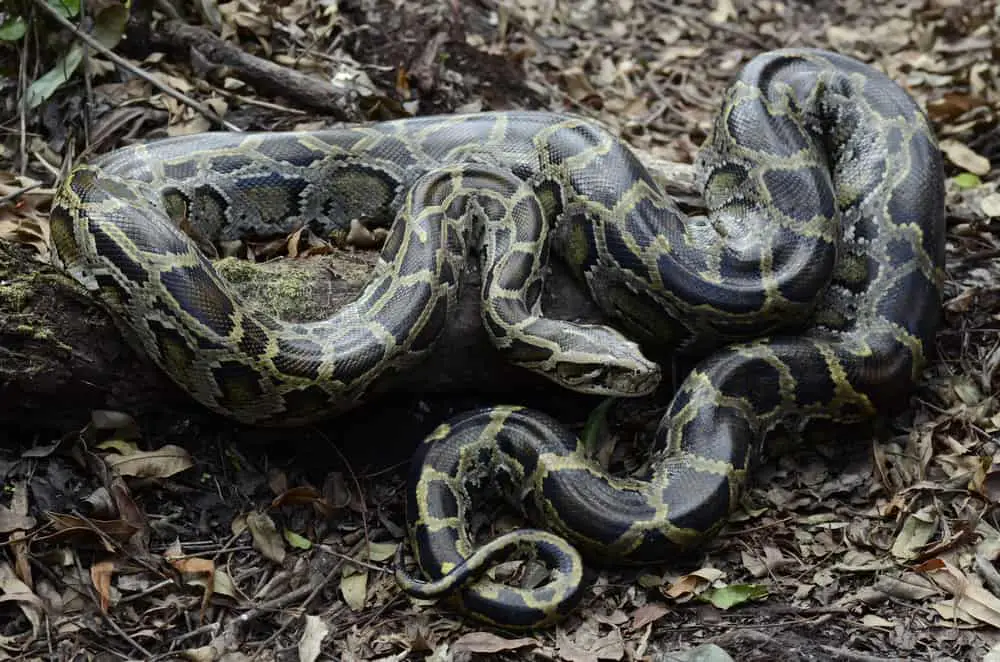
When most of us think of giant constrictor snakes, our first thoughts go to Anacondas (thank you, Hollywood); however, they are not alone! Pythons are another group (genus) of constrictors that are found in various sizes, spread across the globe. These snakes have adapted to a range of different conditions and food types.
Below we’ll take a look at the different types of pythons.
Within the Pythonidae family, 41 species belong to nine different genera. The genus Python (true pythons) currently has ten recognized species: African Rock (and Southern Rock), Angolan, Burmese, Borneo, Malaysian Blood, Myanmar short-tailed, Sumatran, Ball, and Indian Pythons.
With around 40 different species in nine genera, we can expect to see a fair amount of diversity within this snake family. But where are they located? What do they eat? And are there any interesting facts about them?
Table of Contents
- A Global Perspective on the Different Species of Pythons
-
A Breakdown of the Genera in the Pythonidae Family
- Pythons in the Genus Antaresia
- Pythons in the Genus Apodora
- Pythons in the Genus Aspidites
-
Pythons in the Genus Bothrochilus (Leiopython)
- 1. D’Albertis Python/Northern White-lipped Python (Bothrochilus albertisii)
- 2. Biak White-lipped Python (Bothrochilus biakensis)
- 3. Bismarck Ringed Python (Bothrochilus boa)
- 4. Karimui Basin White-lipped Python (Bothrochilus fredparkeri)
- 5. Huon Peninsula White-lipped Python (Bothrochilus huonensis)
- 6. Southern Whitelip Python/Southern White-lipped Python (Bothrochilus meridionalis)
- 7. Wau White-lipped Python (Bothrochilus montanus)
- Pythons in the Genus Liasis
- Pythons in the Genus Malayopython
- Pythons in the Genus Morelia
-
Pythons in the Genus Python
- 1. Anchieta’s Dwarf Python/Angolan Python (Python anchietae)
- 2. Burmese Python (Python bivittatus)
- 3. Bornean Short-tailed Python (Python breitensteini)
- 4. Brongersma’s short-tailed python (Python Brongersmai)
- 5. Sumatran Short-tailed Python (Python curtus)
- 6. Myanmar Short-tailed Python (Python kyaiktiyo)
- 7. Indian Rock Python (Python molurus)
- 8. Southern African Python/Lesser African Python (Python natalensis)
- 9. Ball Python/Royal Python (Python regius)
- 10. African Rock Python (Python sebae)
-
Pythons in the Genus Simalia
- 1. Amethystine Python/Scrub Python (Simalia amethistina)
- 2. Black Python/Boelen’s Python (Simalia boeleni)
- 3. Southern Moluccan Python (Simalia clastolepis)
- 4. Australian Scrub Python (Simalia kinghorni)
- 5. Tanimbar Python (Simalia nauta)
- 6. Oenpelli Rock Python (Simalia oenpelliensis) (Also Called Nyctophilopython oenpelliensis)
- 7. Halmahera Python (Simalia tracyae)
- Conclusion
A Global Perspective on the Different Species of Pythons

The name “python” refers to both the snakes belonging to the python genus of the Pythonidae family and snakes belonging to the Pythonidae family.
Pythons lack venom and are constrictors, meaning they kill their prey by crushing and suffocating it with their muscular bodies.
Pythons naturally occur in Africa (Sub-Saharan), Asia (primarily Southeast), and Oceania. They generally inhabit areas that are arboreal, aquatic, and terrestrial.
There are 41 described species in the family Pythonidae found in nine genera; this excludes sub-species. There are currently ten species of “true” python (snakes found in the Python genus) of which we know.
The genera found within Pythonidae are:
Antaresia – 5 species
Apodora – 1 species
Aspidites – 2 species
Bothrochilus – 7 species
Liasis – 3 species
Malayopython – 2 species
Morelia – 4 species
Python – 10 species
Simalia – 7 species
Note: Within the scientific world, there are many endeavors at classification and reclassification. As a result, different sources class different pythons as either subspecies or as separate species.
For the purpose of this blog, we are using the taxonomical evidence as put out by McDiarmid, Roy W., Jonathan A. Campbell, and T’Shaka A. Touré in 1999, on the Integrated Taxonomic Information System – Report’s website.
A Breakdown of the Genera in the Pythonidae Family
Below is a list of the nine genera found within the Pythonidae family and the species found within those genera.
Pythons in the Genus Antaresia
The genus is also known as “Children’s Pythons” after John George Children.
1. Children’s Python (Antaresia childreni)
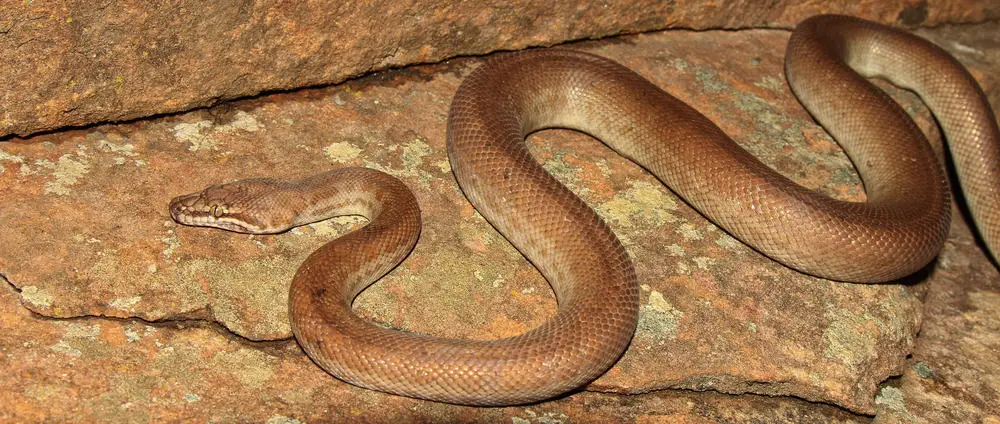
- Location: Northern Australia
- Length: around three-feet
- Diet: mammals and small birds
- Color: Red-brown with dark spots on top and a rainbow hue in the sunlight. They have a dark line through the eye and a yellow belly.
2. Spotted Python/Eastern Children’s Python (Antaresia maculosa)

- Location: Northern Australia
- Length: 39–55inches
- Diet: insectivore bats, mammals, small birds
- Color: brown, with an irregular spot pattern
3. Pygmy Python (Antaresia perthensis)

- Location: Northwest Australia
- Length: 23.6inches
- Diet: geckos
- Color: pale brown to brick-red back, with black crossbars and a white belly. They have a red-brown head, occasionally with dark brown specks on top.
4. Papuan Spotted Python (Antaresia papuensis)
(Recently described as a new species)
- Location: Southern New Guinea
- Length: around 43inches
- Diet: mammals and birds
- Color: light to dark brown with irregular spots along its back.
5. Stimson’s Python/Large-blotched Python (Antaresia stimsoni)

- Location: Arid regions of Australia
- Length: around 39.3inches
- Diet: small mammals, frogs, and birds
- Color: light brown or beige base color, with irregular patches of brown to dark terra cotta. Patterns and colors change across the distribution.
Pythons in the Genus Apodora
These snakes can change the color of their heads, eyes, and bodies, which is reputedly linked to mood.
1. Papuan Olive Python/Papuan Python (Apodora papuana)

- Location: New Guinea
- Length: up to 17feet
- Diet: mammals and other snakes
- Color: olive green, with lighter flanks and belly, but the color can change.
Pythons in the Genus Aspidites
This genus is endemic to Australia, and snakes are known for their symmetrical-shaped heads.
1. Black-headed Python (Aspidites melanocephalus)

- Location: Northern Australia
- Length: 4.9 – 6.6feet
- Diet: reptiles (mainly skinks)
- Color: a glossy black hood and a brown-to-tan body, with irregular bands.
2. Ramsay’s Python/Woma Python (Aspidites ramsayi)

- Location: West and Central Australia
- Length: around 4.5feet
- Diet: mammals, birds, and lizards
- Color: brown to black body with dark bands and dark scales around the eyes. They have a cream or light yellow belly with pink/brown patches.
Pythons in the Genus Bothrochilus (Leiopython)
Some of the snakes in this genus were reclassified from the Leiopython genus. They are native to New Guinea and the surrounding islands.
These snakes are similar in terms of size and diet but are found on different islands. There is limited information available on some species.
1. D’Albertis Python/Northern White-lipped Python (Bothrochilus albertisii)

- Location: New Guinea
- Length: 6 – 7feet
- Diet: mammals and birds
- Color: brown-violet or blue-black, from the neck fading to yellow or gray, bodies, with a shiny black head and black-marked, white labial scales.
2. Biak White-lipped Python (Bothrochilus biakensis)
- Location: The island of Biak (New Guinea)
3. Bismarck Ringed Python (Bothrochilus boa)

- Location: Bismarck Islands
- Length: 4 – 7feet
- Diet: rodents
- Color: Orange-brown to black, with dark rings along the body. They have a black head, and their coloration changes from juvenile to adult.
4. Karimui Basin White-lipped Python (Bothrochilus fredparkeri)
- Location: Eastern New Guinea
- Length: around 8feet
- Diet: mammals
- Color: black head with a dark grey, brown or black body.
5. Huon Peninsula White-lipped Python (Bothrochilus huonensis)
- Location: Eastern New Guinea
6. Southern Whitelip Python/Southern White-lipped Python (Bothrochilus meridionalis)
- Location: Australia, Eastern New Guinea, and Indonesia
7. Wau White-lipped Python (Bothrochilus montanus)
- Location: Eastern New Guinea
Pythons in the Genus Liasis
Snakes in this genus are found in Australia, Indonesia, and New Guinea. There is an extinct species, Liasis dubudingala, which grew to an immense 33feet.
1. Brown Water Python (Liasis fuscus)

- Location: Australia and New Guinea
- Length: 6 – 8feet
- Diet: mammals and birds
- Color: dark brown to black back with a yellow belly.
2. Macklot’s Python/Freckled Python (Liasis mackloti)

- Location: Indonesia and New Guinea
- Length: around 7feet
- Diet: mammals, birds, and reptiles
- Color: scales have a rainbow hue, with light-colored “freckles” on a body of olive green to dark brown. Their necks are cream-colored, changing to brown at the tail (underneath).
3. Olive Python (Liasis olivaceus)

- Location: endemic to Australia (northern areas)
- Length: 8.2 – 13feet
- Diet: mammals, birds, and reptiles
- Color: brown or olive body, with a white belly and pale lips.
Pythons in the Genus Malayopython
These snakes occur in India and Southeast Asia. Originally part of the python genus, experts separated these two species into their own genus.
The reticulated python is the longest species of snake.
1. Reticulated Python (Malayopython reticulatus)

- Location: South and Southeast Asia
- Length: 4foot 11inches – 21foot 4inches
- Diet: mammals, sometimes birds
- Color: olive green with a reticulated pattern (irregular diamonds and similar geometric shapes) on their backs with light centers framed by black. Location influences the color of a snake.
2. Timor Python/Lesser Sundas Python (Malayopython timoriensis)
- Location: Southeast Asia
- Length: around 6 – 8foot
- Diet: mammals and birds
- Color: light golden-brown bodies which darken to chocolate brown at the tail, with light gold spots.
Pythons in the Genus Morelia
Snakes in this genus are usually arboreal and semi-arboreal. They are found across Australia, Indonesia, and New Guinea.
1. Centralian Carpet Python (Morelia bredli)

- Location: Central Australia
- Length: 6foot 5inches
- Diet: mammals and birds
- Color: brown to red-brown with black borders surrounding pale markings. The belly is pale cream to yellow.
2. Rough-scaled Python (Morelia carinata)

- Location: Endemic to Australia (Western)
- Length: around 6.6feet
- Diet: mammals and birds
- Color: light tan with darker red-brown markings, alternatively dark brown with pale brown markings. They have white bellies.
3. Diamond Python/Carpet Python (Morelia spilota)
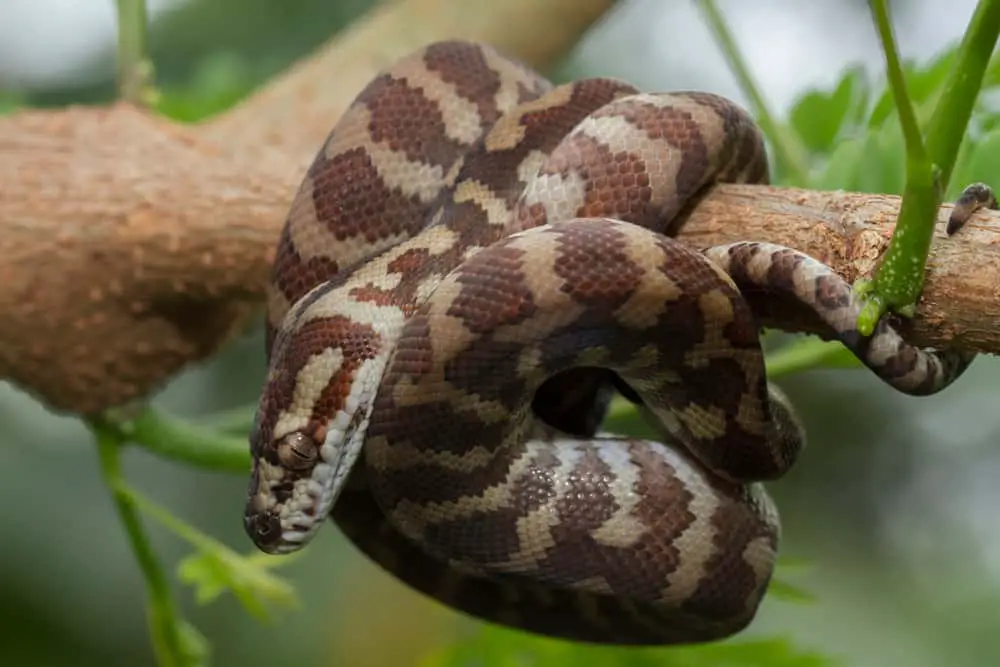
- Location: Australia, Indonesia, and New Guinea
- Length: around 6.5 – 12feet
- Diet: mammals and birds
- Color: they have an oriental carpet pattern of black/grey spots, stripes, or cross bands. They have a light yellow to dark brown base color.
4. Green Tree Python/Southern Green Python (Morelia viridis)

(It is believed that Morelia azurea is a separate species occurring in Northern New Guinea and no longer a subspecies of M. viridis)
- Location: Australia (Northeastern), Indonesia (Eastern), and New Guinea
- Length: 4 – 6feet
- Diet: birds, bats, frogs, and reptiles
- Color: emerald green with white flecks.
Pythons in the Genus Python
These are the “true pythons” and feature the largest group of species. These snakes occur throughout the Pythonidae range (Africa, Asia, and Oceania).
1. Anchieta’s Dwarf Python/Angolan Python (Python anchietae)

- Location: Endemic to Southern Africa (Angola and Namibia)
- Length: up to 6foot
- Diet: mammals and birds
- Color: a red-brown base, brown or black, with irregular white or cream spots or bands. They have an almost yellow belly.
2. Burmese Python (Python bivittatus)

- Location: Southern and Southeast Asia
- Length: around 16feet
- Diet: mammals, birds, reptiles, and amphibians
- Color: a tan base color, broken up by black-bordered, dark brown spots. There is a dark triangle on the head and a white line under the eyes. They have a light-colored belly. Many color variations occur, which include albinos.
3. Bornean Short-tailed Python (Python breitensteini)

- Location: Southeast Asia (Borneo Island), also Indonesia and Malaysia
- Length: 4.9 – 7feet
- Diet: Mammals and birds
- Color: Named for their blood-red markings (also found in brown) on a tan base body. The patterns are irregular.
4. Brongersma’s short-tailed python (Python Brongersmai)
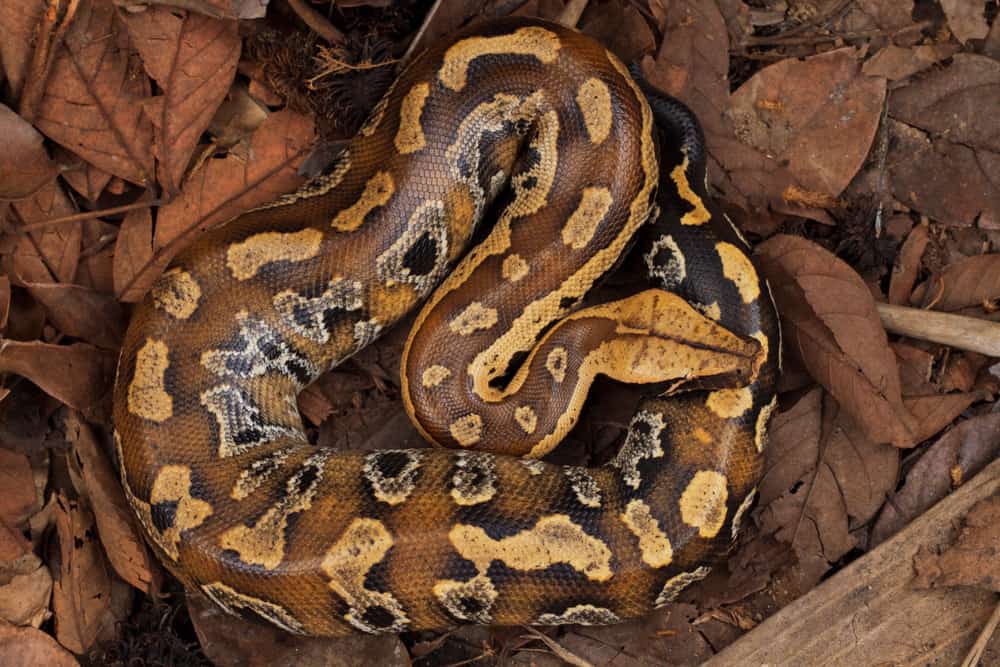
- Location: Southeast Asia (Western Malaysia, Sumatra, Thailand)
- Length: 36 – 72inches
- Diet: Mammals and birds
- Color: There are four color variations, brown, orange, red, and yellow. They generally have yellow and tan spots and stripes over the body and tan or black spots on the sides. They have a white belly and a grey head, with a white stripe behind the eye.
5. Sumatran Short-tailed Python (Python curtus)

(Originally, Python breitensteini and Python Brongersmai were subspecies of this species)
- Location: Indonesia (Sumatra), West Malaysia, and Thailand
- Length: 4.9–5.9feet
- Diet: Mammals and birds
- Color: Beige, gray-brown, or tan base color with a pattern of red (brick to blood) spots covering the body.
6. Myanmar Short-tailed Python (Python kyaiktiyo)
(Originally believed to be part of Python Brongersmai, but recently (2011) became a separate species)
- Location: Myanmar
- Length: up to 6feet
- Diet: mammals and birds
- Color: Rusty or dark brown/black colored stripes and spots on a light brown to red-brown base.
7. Indian Rock Python (Python molurus)

- Location: Southeast Asia (India, Eastern Pakistan, Bangladesh, and Sri Lanka)
- Length: up to 19feet
- Diet: mammals, birds, and reptiles
- Color: The color varies according to terrain and habitat, but generally a base of orange-brown or yellow-brown, with tan to dark brown patches. The head has a “V” pattern of a lighter color.
8. Southern African Python/Lesser African Python (Python natalensis)

- Location: Eastern and Southern Africa (Southern Kenya to South Africa)
- Length: 14 – 16feet
- Diet: mammals, birds, fish, and reptiles
- Color: Dark brown base, with grey-brown patches and dark spots across the body. They have a lighter “V” shape mark on their heads, with dark lines starting from in front of the eyes moving forwards and a white belly.
9. Ball Python/Royal Python (Python regius)

- Location: West and Central Africa
- Length: 3.5 – 4.5feet
- Diet: small mammals and birds
- Color: Dark brown or black base, with light brown patches on the back and sides. They have a white or cream belly.
10. African Rock Python (Python sebae)

- Location: West and Central Africa
- Length: up to 19.7feet
- Diet: mammals and birds
- Color: Similar to the Southern African Python, but only more significant in size.
Pythons in the Genus Simalia
Snakes in this genus were initially part of Liasis and Morelia but are classified as their own genus.
1. Amethystine Python/Scrub Python (Simalia amethistina)
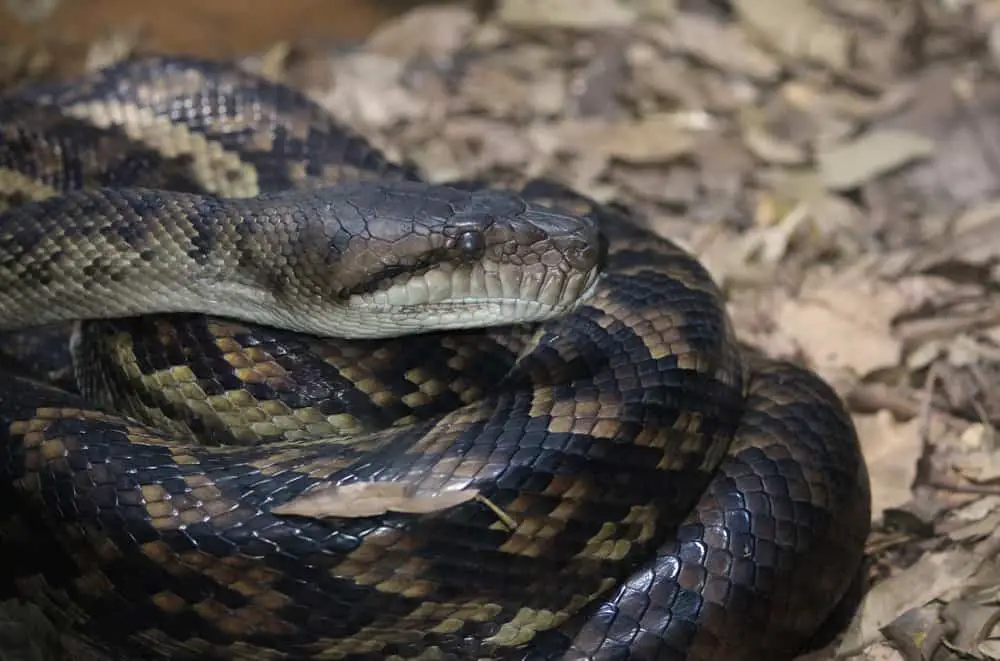
- Location: Australia, Indonesia, and New Guinea
- Length: 16.4 – 27.8feet
- Diet: mammals and birds
- Color: Olive-brown or yellow-green base with purple/blue hue to the scales.
2. Black Python/Boelen’s Python (Simalia boeleni)
- Location: Indonesia and Western New Guinea
- Length: up to 9.8feet
- Diet: Mammals, birds, and reptiles
- Color: dark blue-black or purple-black base with white streaks on the sides. The belly is white to yellow, and the lips are also light.
3. Southern Moluccan Python (Simalia clastolepis)

- Location: Indonesia
- Length: 8 – 9feet
- Color: Yellow base with a black pattern on their backs, alternatively patternless.
4. Australian Scrub Python (Simalia kinghorni)

- Location: Australia (Northern)
- Length: up to 24feet
- Diet: mammals, birds, and reptiles
- Color: brown and tan form an ornate pattern on the back, with a white to yellow belly. There are lots of variations in the patterns.
5. Tanimbar Python (Simalia nauta)
- Location: Indonesia
6. Oenpelli Rock Python (Simalia oenpelliensis) (Also Called Nyctophilopython oenpelliensis)

- Location: Endemic to Australia (Northern Territory)
- Length: 13 – 16feet
- Diet: Mammals and birds
- Color: Olive-brown, with darker patches, creates a pattern on the back, while the belly is cream to yellow. Most interesting is that these snakes can change their color. They shift from darker during the day to lighter at night.
7. Halmahera Python (Simalia tracyae)
- Location: Endemic to Halmahera Island (Indonesia)
- Length: 8.2 – 13.1feet
- Diet: fruit bats (and other mammals) and birds
- Color: a rounded snout, black tongue, pale blue-grey oral mucosa, and diagnostic red irises are identifying features.
They also have 48-56 dark brown/black bands on the body (darkest in the middle of the back). There is also a black stripe from behind the eyes, with black stripes around the neck.
Conclusion
Pythons are some of the world’s most sizable snakes. They are constrictors located in Africa, Asia, and Oceania. Within the family Pythonidae, there are around 40 species in nine to ten different genera. There is, however, a lot of debate within the scientific community regarding some species, while others lack the majority of information.
These giant (and some smaller) snakes are vital to their environments and need protection to ensure proper ecosystem functioning.
Sources:
World Atlas: How Many types of Pythons Live in the World Today
Live Science: Python Facts
National Zoo: Green Tree Python
ITIS: Pythonidae
JCU: Antaresia Maculosa
Animal Diversity: Antaresia Perthensis
Australian Government: Olive Python
The Spruce Pets: Green Tree Python
